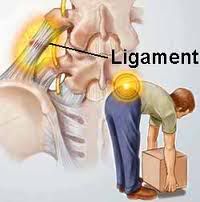A strain is a stretching injury to a muscle or a musculotendinous unit caused by mechanical overloading. This type of injury may result from an unusual muscle contraction or an excessive forcible stretch. Although there usually is no external evidence of a specific injury, pain, stiffness, and swelling exist. The most common sites for muscle strains are the lower back and the cervical region of the spine. The elbow and the shoulder are also supported by musculotendinous units that are subject to strains. Foot strain is associated with the weight-bearing stresses of the feet; it may be caused by inadequate muscular and ligamentous support, over weight, or excessive exercise such as standing, walking, or running.
In the lumbar and cervical spine regions, muscle strains are more common than sprains. Mechanical low back pain is becoming increasingly common in the adolescent athlete. Overuse, specially hyper-extension of the lumbar spine in such sports as track, wrestling, gymnastics, and diving, can tear the muscles, fascia, and ligaments. Careful diagnosis is necessary because chronic low back pain may indicate a stress fracture. Fractures near the top and bottom surface of the vertebrae can occur when the growing lumbar spine is overstressed, causing the disks to push into the spinal nerve roots. Early detection and treatment are important to prevent complications and disability. Treatment of back strains consist of bed rest, traction, application of heat, and massage. Exercises, correct posture, and good body mechanics help to reduce the risk of injury.
Treatment
- For injured extremity elevate the affected area and apply cold compress for the first 24 hours.
- Compression (to reduce swelling and provide support by placing adhesive wraps or a removable splint.)
- Immobilize the affected area until pain and swelling subsides.
- Immobilization may be followed by graded active exercises.







0 comments:
Post a Comment